
Architectural Styles and Revivals: The Gothic Revival
(written by Dr. Les Crocker, UWL Emeritus Professor of Art History)
The Gothic Revival began at about the same time as the interest in the classical world did and lasted into the mid-nineteenth century in the U.S. There were at least three separate aspects of the style, each promoted by a different cultural concern. College Gothic was based on the idea that the earliest universities were created by the Catholic Church and, thus, even modern universities should use the old style.
The Religious Gothic Revival in England was part of a resurgence of the Catholic religion in that country. The Protestant-Catholic conflict had been going on since Henry VIII and would continue into the twentieth century.
The third aspect of the Gothic Revival, was what I call the Romantic Gothic Revival. It cared nothing about religious differences or where the first universities came from. Unlike the Greek or Roman style, the Gothic was all over England. Castles and manor houses were more varied than churches and without the dogma of religion, their appearance was only limited by one’s imagination.
The English interest in their roots was aided by the surviving literary works, especially the Arthurian tales. Every English nobleman wanted to trace his ancestry back to the Middle Ages. Ladies in distress, knights in armor, and heroic battles were much more interesting to the general public than the aesthetic hair splitting and esoteric themes of Immanuel Kant and the like. The novels of Sir Walter Scott brought the Middle Ages alive and made the Gothic era more like their own time and thus more understandable. Although excavations at Herculaneum and Pompeii had begun in the mid-1700s, very little was known about everyday life in the ancient world; whereas, the stories and artifacts of the medieval world were still much in evidence in England, even if in a much-deteriorated form.
A more generalized medieval style than Gothic appeared in the early 20th century. They were given names from medieval cultures like, Anglo, Norman, Anglo-Norman, Tudor, and Elizabethan, to name only a few. Any connection to the named culture was strictly superficial and mostly to separate your style from the one next door.
As for the details of the style, often it seems to take nothing more than a pointed arch to achieve the 'distinction' of being Gothic Revival. Instead, I think of such usage as being one element in the overall design. Are the pointed arches truly load bearing, that is, functional or are they decorative? What about the other decorations? Are they based on Gothic prototypes? Is the ground plan Gothic? Are the columns Gothic? On and on.
Gothic Houses
In 1853, the newspaper The La Crosse National Democrat published an article about the recent construction of several Gothic cottages on Fourth and Fifth streets, but took special note of the building of a Mr. Whelpley on Fifth Street which was “one of the most commanding and ornamental dwellings in town. Under the main building is a splendid cellar, walled & pointed, completely ratproof. The Gothic order of architecture will be observed and when completed it will be truly an ornament to the place.”
This was probably William Whelpley, listed in Rev. Spencer Carr’s A Brief Sketch of La Crosse, Wisconsin of 1854, who was from Massachusetts and listed himself as a farmer. Like many early structures we only have the description of the house.
Colton-Manville House 214 S. 8th Street. Built: 1859. Attributed to William H. J. Nichols. Demolished.
This wonderful Gothic Revival cottage was built in 1859 for Marcus F. Colton and an engraving of it appeared in Butterfield's History of La Crosse County from 1881. It is similar to the Cephas Martindale cottage with a steep gable roof, decorated chimney and pointed arches above the windows. Although most buildings from the Gothic period were built of stone, wood was the preferred medium in the Midwest where stone was not always available, expensive to use and trained masons and stone carvers not available.
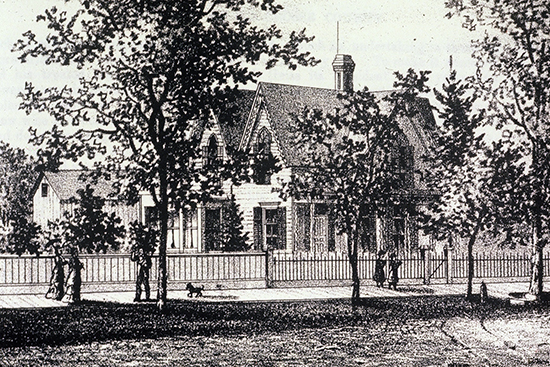
Engraving of the Colton-Manville House in History of La Crosse County from 1881.
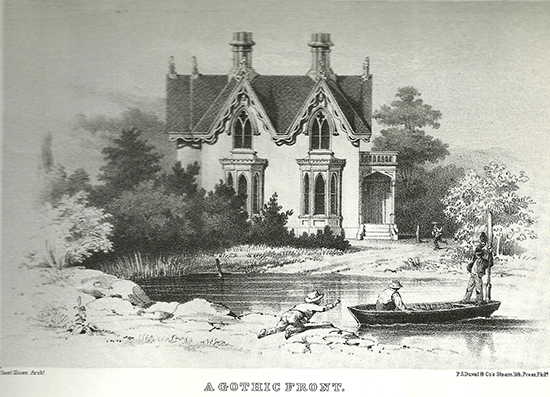
An engraving showing an example of a Gothic front elevation from a building design book by Samuel Sloan.
William H.J. Nichols House Pine & Third streets. Moved to 1200 West Ave. S. or SE corner of State Street and West Ave. Built: 1856, 1870. Demolished.
The original portion of the house of the carpenter/architect W. H. J. Nichols was built in 1856 at Pine and Third Sreets. A Gothic section was added in 1870 at a cost of $2,500 and the house moved to the southeast corner of State St. and West Ave. The new portion is to the right of the large pointed arch beneath a steep gable. The new entrance is supported by colonettes, small columns, set on pedestals, a design motif Nichols also used on the Italianate Martindale house at 10th and Cass St. in 1860. The large arched window with three sections was most likely in the dining room.
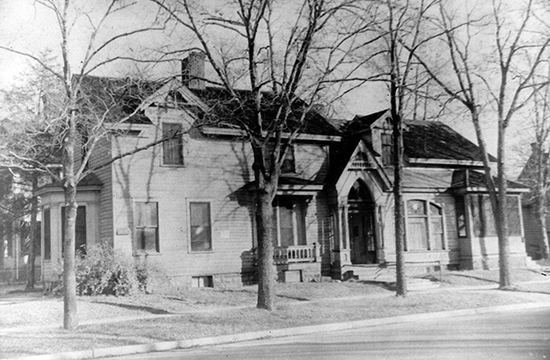
The home of builder William H. J. Nichols.
There were few large houses in La Crosse before the 1870s so the few examples of the Gothic Revival were mostly cottages.
Cephas Martindale Cottage, 714 Cass St. Built: 1859
Cephas (some sources use the spelling “Cyphus”) bore a Roman name but lived in a Gothic Revival cottage that today is the last of a once common form. The bay that extends toward the street uses board and batten construction, wide boards set vertically with narrow battens covering the joints, a very common method of building in the Gothic Revival. The porch on the left side has been enclosed to make an extra room and the decorative woodwork across the top of the porch has been removed since this photo was made in 1977. The steep roof makes dramatic gables with decorative barge boards in a wave pattern. The square porch columns sport capitals that branch and echo the curves of the barge boards.
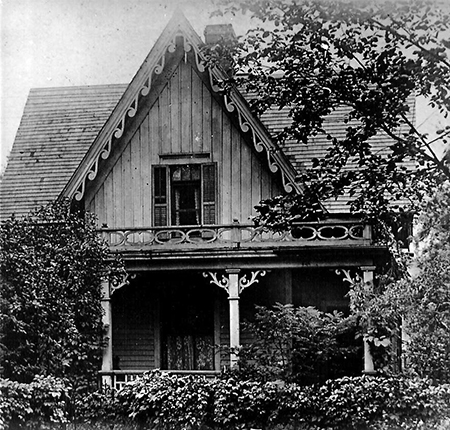
An early photo of the Cephas Martindale home.
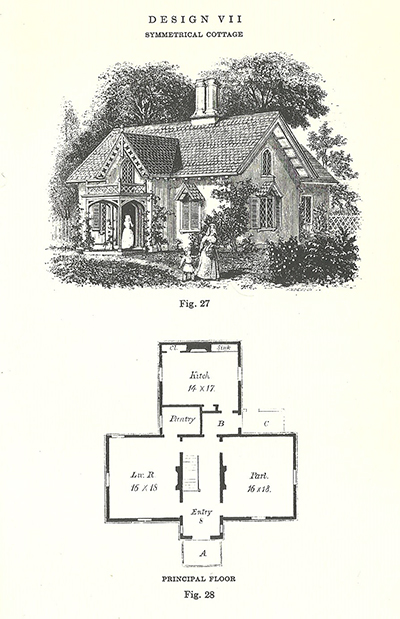
A plate from Andrew Jackson Downing's The Architecture of Country Houses from 1850 (as reprinted by Dover Publications, New York, 1969) shows a similar cottage with its interior layout.

Photograph of the Martindale home showing the balustrade still along the top of the porch. 1977 photo by author.
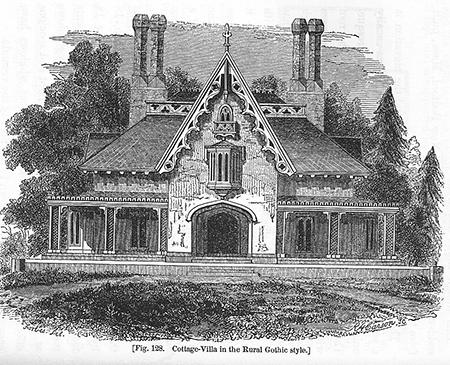
This design from Downing's The Architecture of Country Houses from 1850 was probably the inspiration for the cottages.
113 Jefferson, West Salem.
This cottage was also based on the design from Downing's Country houses published in 1859. The house was probably designed by W.H.J. Nichols, who did most of the finer houses in the area. Quality designs in the latest fashion by Nichols were made possible out on the frontier by the use of design books showing what was being built in the big cities back east.

An example of Gothic architecture in West Salem. 2016 photo by author.
1019 Cass St. Built: 1872
This little house at 1019 Cass was built in 1872 as a rental half house. It uses the same design as the other cottages but the wing on the right side was never built. The steep roof and cut-out clover leaves in the barge boards clearly link it to the Gothic Revival, although this is certainly the less expensive version. The new windows are not in proportion to the old ones, the decorative barge boards are gone. The enclosed front porch has been extended along the alley in three different additions. You could pass this house hundreds of times and never realize its original appearance. The architectural remains of the past are not just in the grand mansions that have been preserved and restored. The city has many bits and pieces that have survived by chance, rather than any intentional preservation.
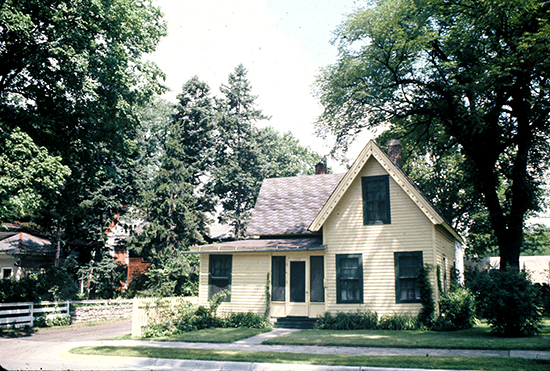
A photograph of 1019 Cass St. that still shows its Gothic elements. 1977 photo by author.

A recent view of 1019 Cass St. showing the now enclosed back porch and altered front. 2023 photo by author.
Sexton’s House, 1409 La Crosse St. Built: 1872. Demolished ca. 1985.
The Gothic Revival is used in this story-and-a-half, L-shaped house, a shape usually associated with the Italianate style. The steep roof and pointed arches of the window heads are the most noticeable features of the Gothic Revival. The ground floor window heads are simple, flat forms with a curl on the outer ends. The upper windows have headers that imitate stone arches and are much wider and more decorative. The lower window decorations are more rustic while those on the upper story are more elaborate and suited to a more grandiose building.
Over all, it is a late example of the of the Gothic Revival Rural Cottage sub-style, which wasn’t used in most places after the Civil War. Perhaps, because this house was for the cemetery sexton, the Oak Grove Association may have felt the old-fashioned style was more suitable for the city of the dead. This house was built thirty years before the gateway arch to the cemetery so it would have been much more noticeable as you rode along the carriage drive that was La Crosse Street.

The sexton’s house near Oak Grove Cemetery. The home was demolished to make way for the Oak Grove Crematorium. 1972 photo by author.
Gothic Commercial Buildings
La Crosse had at least one large building in the Gothic Style. A. W. Barron, a carpenter from New York, built an early hotel at State and Third Streets, next to the Tallmadge House. We don't have any image of Barron's hotel but it was described by a reporter:
“Mr. A. W. Barron has erected one of the most substantial buildings in town, between Tallmadge House and Carlton’s store fronting the West. Beautiful front with a piazza on both stories, octagon pillars 20 feet high with capitals resembling somewhat the style of ancient castles.”
La Crosse National Democrat, September 6, 1853
Gothic Religious Buildings
One would think that the Gothic Revival style would be common in local church construction, but most Protestant churches were simple rectangular buildings that could have been used as a barn, meeting hall, theater or most any other gathering place. In the U.S., the Gothic Revival was often the preferred style for Catholic and Episcopal churches, while the Protestants used a New England Classical style. However, these distinctions didn't last very long into the 1800s. In La Crosse, the style was used in two of the earliest churches.
First Christ Episcopal Church, NW corner of Main and 9th streets. Built: 1863. Demolished.
Gothic churches didn't have detached or semi-detached bell towers so right away this building isn't authentic, but it has board and batten construction which is okay for rural buildings, which this certainly was in a town of about four thousand on the edge of the frontier in 1863. The steep gable roof and pointed arches for the doors and windows are typical for the style, however the dormer windows in the roof are not typical for any style of church.
The interior was like nothing else ever in La Crosse. The scissor trusses on hammer beams corbelled into the wall are very sophisticated timber work, just.the kind of technology that was disappearing because of dimension lumber, saw mills, and nails. In 1863, W.H.J. Nichols was the only designer in the town that could have done this interior. He was trained as a heavy timber carpenter and he used books on architecture to guide and inspire himself. I don't know the source of this particular building, but it was of a type common in England during their late-Gothic period, and would have been known through books with engravings.

The exterior of the old Christ Episcopal Church at the northwest corner of Main & 9th Streets.
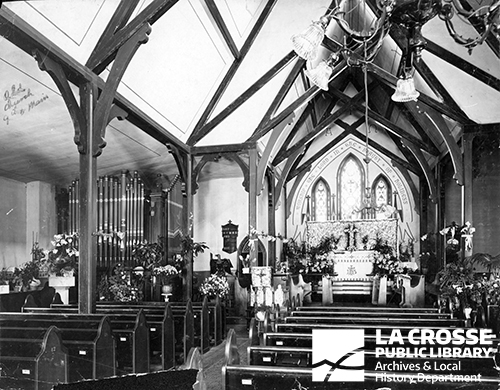
A view of the interior showing the timber work.
First St Joseph Cathedral, SW corner of Main and 6th streets. Built: 1870. Demolished.
St Joseph's Parish was created in 1863 primarily for the numerous Germans in the area. It became the cathedral and there is some indication that Charles Ross designed old St. Joseph's in 1869.
The exterior of the first St. Joseph's shows a rectangular building 62 x 140 feet with pointed arches holding the side window and pinnacles rising above the roof eaves at the pilaster buttresses that thicken the wall.
In contrast to the first Christ Episcopal church, the first St. Joseph structure was a high Gothic hall church with pointed rib vaults supported on tall Corinthian columns. In the hall church form, the side aisles are as tall, or almost as tall, as the central aisle, so there are no clerestory windows. Hall churches were most used in Central and Eastern Europe, and most of the early congregants were from the Germanic areas of Europe. As the old photo indicates, the central aisle, especially the upper part, would have been rather dark.
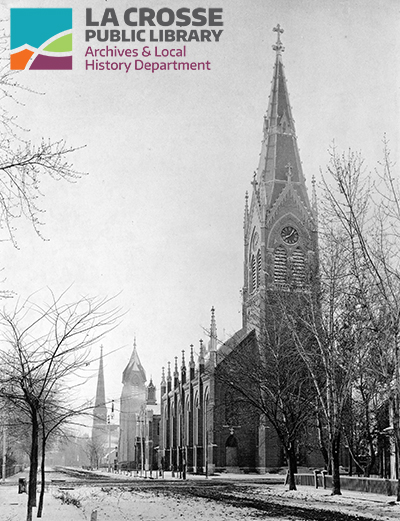
Exterior of the original St. Joseph Cathedral at the southeast corner of Main & 6th Streets.
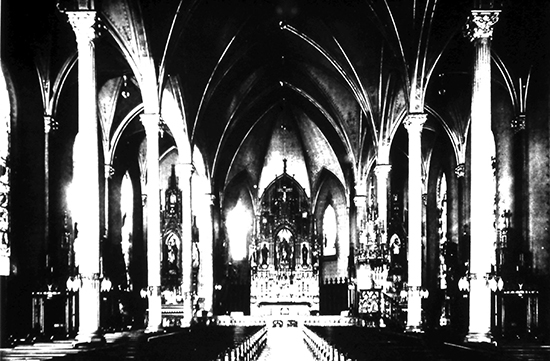
A view of the inside, looking toward the altar, shows off the Gothic hall form.
The Civil War mostly ended the three early revivals, Roman, Greek and Gothic in much of the United States. The world had changed. The rationality behind Roman and Greek culture no longer fit the divided nation. The romantically written battles of the Gothic world sounded rather false after the horrors of prison camps and the burning of cities in your home state.
Today, the Cephus Martindale house is the only remaining example of the “Cottage Gothic” sub-style in La Crosse, although pointed arches do appear as decorative features in some Italianate examples.
While the revival of buildings from the ancient and medieval worlds were the dominant styles in the late nineteenth century, other styles or fads based more or less on buildings from non-Western cultures appeared and the nature of styles changed from historical to decorative. More on that next week.
Other entries in this series
Architectural Styles and Revivals
Architectural Styles and Revivals: The Greek and Roman Revivals
Architectural Styles and Revivals: The Exotic Revival
Architectural Styles and Revivals: The Italianate Style
Architectural Styles and Revivals: The Second Empire Style
Architectural Styles and Revivals: The Queen Anne Style
Architectural Styles and Revivals: The Colonial Revival
Architectural Styles and Revivals: Romanesque Revival Public Buildings
Architectural Styles and Revivals: Romanesque Revival Commercial Buildings
Architectural Styles and Revivals: Romanesque Revival Homes
Architectural Styles and Revivals: Religious Romanesque
